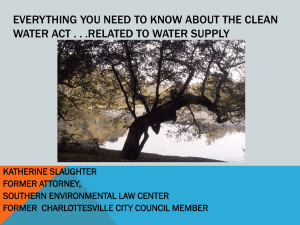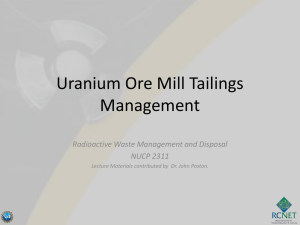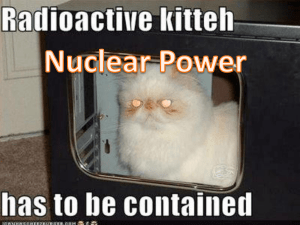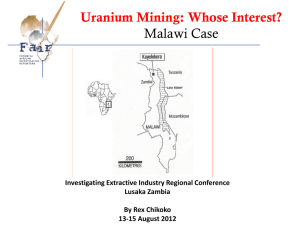ppt. presentation - City of Virginia Beach
advertisement
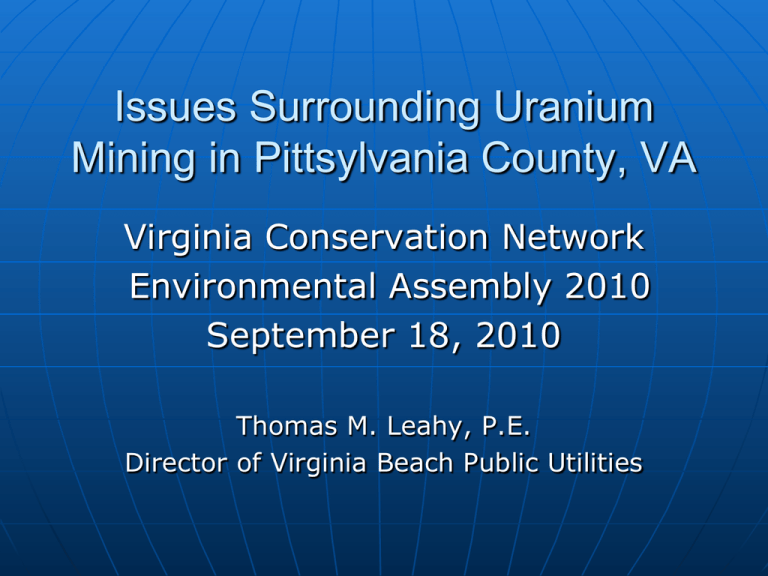
Issues Surrounding Uranium Mining in Pittsylvania County, VA Virginia Conservation Network Environmental Assembly 2010 September 18, 2010 Thomas M. Leahy, P.E. Director of Virginia Beach Public Utilities Uranium Mining There are several ways to mine uranium, but in Pittsylvania, VA open pit mining is most likely Uranium ore is excavated from deep under ground The ore is milled into very small sand and clay-like particles Uranium is leached from the ore and recovered as uranium oxide Leftover ore sediments are known as Uranium Mill Tailings Uranium Mill Tailings One ton of uranium ore produces 2 lbs of uranium oxide (yellowcake) and 1,998 lbs of uranium mill tailings Unlike buried ore, tailings are very susceptible to transport by air & water Overburden, clay, and liners are used to construct confinement cells and caps to confine the tailings Mill tailings retain 85% of the original radioactivity for >>> 300,000 years Uranium Mining in VA: 1973-85 1973-78: Uranium prices create push to mine uranium in the Piedmont of Virginia 1979-82: Three Mile Island, and decades of uranium mining/milling pollution in the west come under public scrutiny 1983: VA General Assembly enacts moratorium on uranium mining 1985: VA Coal and Energy Commission recommends lifting moratorium Uranium prices drop and remain low - the moratorium remains in effect Uranium Mining in VA: 2007-08 Skyrocketing uranium prices renew interest in uranium mining in Pittsylvania County Deposits in Cole’s Hill may be worth billions VA Uranium (a VA firm) and VA Energy Resources (a Canadian firm) are formed to mine the deposits in Pittsylvania County • Better define the deposits at Cole’s Hill • Conduct Public Relations campaign • Convince the Virginia General Assembly to lift the moratorium on uranium mining Uranium Mining in VA: 2009-10 VA Coal and Energy Commission has commissioned the NRC/NAS to conduct a study on uranium mining in Virginia Funding is provided by Virginia Uranium, but escrowed through VA Center for Coal and Energy Research The NRC/NAS Study will not include sitespecific analysis, hydrologic or water quality modeling, or failure analysis VA Beach is undertaking a failure analysis to provide to the NRC/NAS Historical Spot Price of Uranium Uranium Mill Tailings Cole’s Hill Site - 100 million pounds of uranium yellowcake 30 million cubic yards of mill tailings 12 confinement cells, each 40 acres and 2.5 million cubic yards Mount Trashmore = 20 acres and 1.3 million cubic yards Depending upon groundwater, much of the cell may be below ground Project Description Coles Hill Water from Lake Gaston is a large percentage of SEVA Water Supply Uranium Tailings Legacy Historically, tailings were not properly confined resulting in radioactive contamination of ground and surface waters Legacy of human and environmental tragedy: 1950’s to early 1980’s 1978: Federal government stepped in to remediate – UMTRCA (DOE, NRC) Clean up has cost billions over three decades – work and costs ongoing UMTRCA Sites – DOE and NRC Source - USEPA The Past vs the Present Uranium mining industry does not dispute past issues with mill tailings They say that modern confinement cell design and NRC regs will protect surface waters NRC regs require that confinement cells be designed for at least 200 yr life or 1,000 yrs if “reasonably achievable” In 1969, a storm in Nelson County was estimated to have caused 2,000 years of erosion in a single night Historically, uranium mines have been located in western states (black dots show mine locations) Climate and landscape features in Virginia produce much greater precipitation & runoff than in western US PMP Storms in Virginia Historically, many uranium tailings confinement failures have been caused by inability to manage water Unlike the west, precipitation in Virginia is high and evaporation is low In Virginia, storms have generated near probable maximum precipitation (PMP) PMP can erode and fragment virtually any earthen structure (man-made or natural) PMP can transport large volumes of sediments downstream very quickly All 23,000 USGS Stream Gages Average Stream flow in Virginia – 1 CFS per Square Mile Stream Gages with Extreme Floods 50 to 300 CFS per Square Mile Probable Maximum Precipitation PMP in Virginia - 1,000 to 7,000 CFS per Square Mile Probable Maximum Precipitation Events in Virginia • Nelson County – August 1969 27 – 31 inches in 8-hours • Madison County – June 1995 30 inches in 14 hours Worst Case Scenario A storm similar to the 1969 Nelson County storm fragments confinement cells and transports radioactive sediments to Kerr Reservoir, and in turn, to Lake Gaston Radiation levels in Kerr/Gaston increase: • To levels near or above state/federal regulatory limits in the Safe Drinking Water Act • To levels less than regulatory limits but significantly greater than existing background Existing treatment plants not designed for removal of radiological contaminants Remedies could be costly/problematic Current Radiological Levels VA Beach-Norfolk Water Systems Current Level EPA/DEQ Limit EPA Goal Unit Gross Alpha Activity 0.4 15 0 pCi/L Gross Beta Activity 3.1 50 0 pCi/L Radium 226/228 0.6 5 0 pCi/L NRC/NAS Study The NRC/NAS Study will not include site-specific analysis, hydrologic or water quality modeling, or failure analysis It’s not a conspiracy – it’s just not what the NRC/NAS is set up to do VA Beach is undertaking the aspects of the study that the NRC/NAS can’t Results will be provided to the NRC/NAS for its consideration VA Beach Failure Analysis Study Phase I Assessment: • Assume a PMP-type catastrophe and sediment release • Estimate of contaminated sediment to reach Kerr Reservoir • Assess potential increase in background radiation levels in Kerr Reservoir Phase II Assessment: • Detailed analysis based on Phase I results (if deemed necessary). Phase I Assessment Banister and Roanoke Rivers CCHE1D: Center for Computational Hydroscience and Engineering at the University of Mississippi CCHE1D simulates unsteady flows and sediment transport in dendritic channel networks CCHE1D also simulates transport and fate of radionuclide's Banister River Watershed Roanoke River Watershed Dan River Watershed One Dimensional Modeling Objectives Following a hypothetical PMP-event which releases certain quantities of mill tailings and effluents into the Banister or Roanoke Rivers: What amount of radionuclide-contaminated sediment and water might reach Kerr Reservoir? • In the short term (i.e. during the high-flow caused by the extreme precipitation event that triggered the failure) and • In the long term (during subsequent high-flow events of lesser magnitude, but higher frequency) What would be the potential increase in background radiation levels and other contaminants levels in Kerr Reservoir? Sensitivity Analysis Model parameters: watershed and sediment coefficients Meteorological Parameters: • Extreme events (500-yr & 100-yr storms) • Small and large released tailings • Short and long duration releases Uncertainty Analysis Volume of the sediment released Initial radioactivity of the tailings and the effluents The distribution coefficients Independent Expert Review Panel Specialized in key disciplines: Uranium Milling/Disposal of Milling Waste/Geotechnical Surface/Sub-Surface Water Contamination Sediment Transport, Unsteady Hydrodynamic Modeling Hydrology Water Chemistry/Treatment Assist in development of the approach for the Phase 1 Review adequacy of data collected, critique the assumptions and the Phase 1 assessment design Review, Critique and Evaluate Phase 1 report and conclusions Current Status Model has been constructed, calibrated and tested Initial scenarios are being run It’s very early – but no surprises yet • Heavier sediments settle closer to point of assumed release • Lighter sediments transported to Kerr • There is some Ra deposition in Kerr Results have not yet been converted to water quality impacts QUESTIONS?


